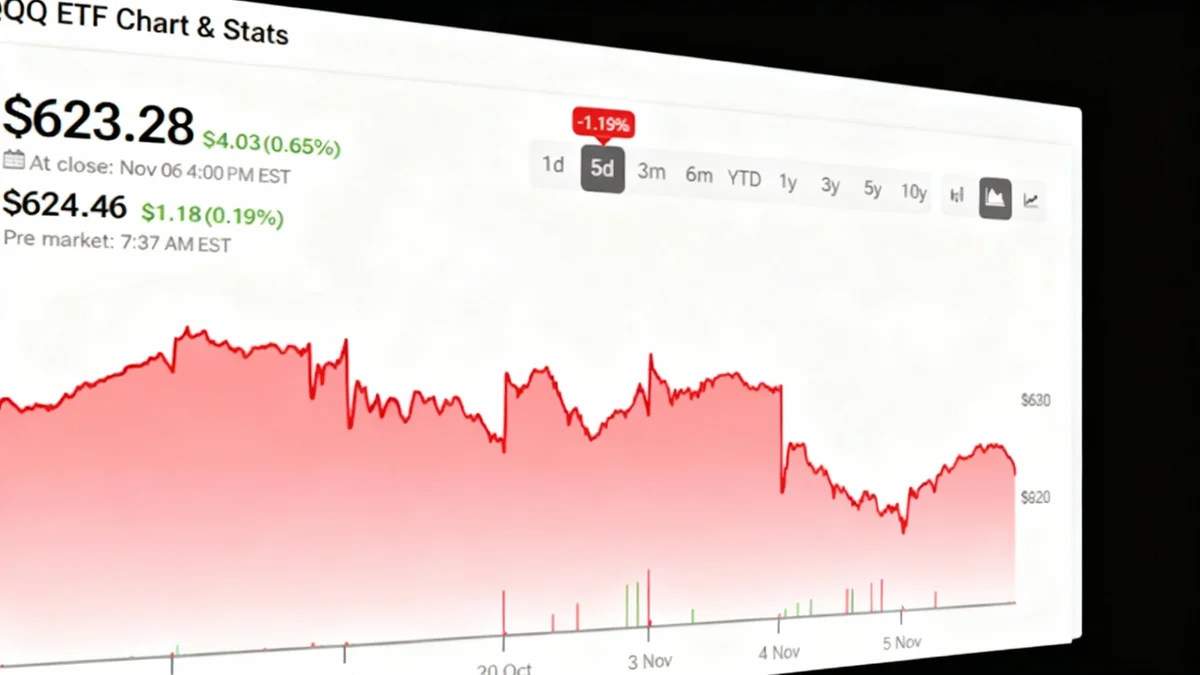U.S. stock markets experienced a significant downturn on Tuesday, with technology shares leading the decline amid growing concerns over the health of the labor market. The NASDAQ Composite fell sharply by over 2%, testing its lowest levels for the week, while the S&P 500 and Dow Jones Industrial Average also posted considerable losses.
The widespread sell-off reflects a shift in investor sentiment, as concerns about a potential economic slowdown overshadow recent market optimism. The downturn was not isolated to equities, with crude oil prices also retreating and the U.S. dollar weakening ahead of crucial employment data.
Key Takeaways
- Major U.S. indices declined, with the tech-heavy NASDAQ falling more than 2%.
- A reversal in technology stocks and reports of increased layoffs are driving market anxiety.
- The U.S. dollar weakened against major currencies as traders anticipated upcoming jobs data.
- Crude oil prices fell after Saudi Arabia reduced its prices for Asian customers, signaling potential demand concerns.
- Ethereum faced pressure from sustained ETF outflows, with its price dropping over 4%.
Technology Sector Leads Broad Market Retreat
The technology sector, a primary driver of market gains this year, faced intense selling pressure. The NASDAQ Composite, which includes giants like Apple, Microsoft, and Nvidia, saw a decline of 2.02%. This sharp drop dragged the broader market down, with the S&P 500 losing 0.88% and the Dow Jones Industrial Average falling by 0.95%.
The reversal appears linked to growing evidence of a cooling economy, including reports of a spike in layoffs across various industries. When companies reduce their workforce, it signals an expectation of lower future earnings and reduced economic activity, prompting investors to sell riskier assets like tech stocks.
Why Tech Stocks Are So Sensitive
Technology companies are often valued based on their potential for future growth. During periods of economic uncertainty, investors become less willing to pay a premium for future earnings that may not materialize. They tend to move their capital into safer assets, leading to significant sell-offs in high-growth sectors like technology.
Dollar Weakens as All Eyes Turn to Jobs Data
In the currency markets, the U.S. dollar lost ground against its major peers. The dollar's retreat comes as traders grow increasingly cautious ahead of the release of key U.S. jobs data. This data is a critical indicator of the economy's strength and heavily influences the Federal Reserve's decisions on interest rates.
A weaker-than-expected jobs report could increase the likelihood of the central bank cutting rates sooner, which typically puts downward pressure on the dollar. The euro gained 0.45% against the dollar, while the British pound rose by a more substantial 0.63%.
Treasury Yields and Precious Metals
Adding to the complex picture, U.S. Treasury yields fell, which usually supports assets that do not pay interest, like gold. However, gold's performance was muted. The precious metal pulled back from its session highs, closing with a modest gain of just 0.17%.
This lukewarm response suggests that even safe-haven assets are struggling for clear direction amid the conflicting economic signals. Other precious metals were mixed, with silver remaining flat and platinum declining by 1.43%.
Market Snapshot: Key Movements
- NASDAQ: -2.02%
- S&P 500: -0.88%
- Dow Jones: -0.95%
- U.S. Dollar Index: Lower
- WTI Crude Oil: -0.21%
- Ethereum: -4.38%
Energy and Crypto Markets Signal Waning Confidence
The sense of caution extended to the energy markets. Both WTI and Brent crude oil prices retreated after Saudi Arabia announced it was cutting its official selling prices for buyers in Asia. This move is widely interpreted as a signal that the world's largest oil exporter is concerned about weakening demand in a key global market.
In contrast, natural gas prices bucked the trend, surging 3.63%. This move was likely driven by factors specific to the natural gas market rather than the broader macroeconomic sentiment.
Ethereum Under Pressure from ETF Outflows
The digital asset space also felt the pressure of risk aversion. Ethereum (ETH), the second-largest cryptocurrency, saw its price fall by 4.38%. The decline coincides with reports that Ethereum-based exchange-traded funds (ETFs) have now experienced six consecutive days of net outflows.
Sustained outflows from investment products like ETFs indicate that institutional and retail investors are reducing their exposure, putting significant selling pressure on the underlying asset. This trend has analysts questioning whether Ethereum's price could fall toward the $3,000 level.
Outlook: Uncertainty Prevails
With major asset classes flashing warning signs, investors are bracing for a period of heightened volatility. The upcoming jobs report will be a critical data point, potentially setting the market's tone for the coming weeks.
If the labor market shows significant weakness, it could confirm fears of a slowdown and lead to further declines in equities and other risk assets. Conversely, a surprisingly strong report might ease recession fears but could also diminish hopes for imminent interest rate cuts, creating a different set of challenges for the market.
For now, caution is the dominant theme, as market participants weigh the dual risks of a cooling economy and persistent uncertainty over central bank policy.





